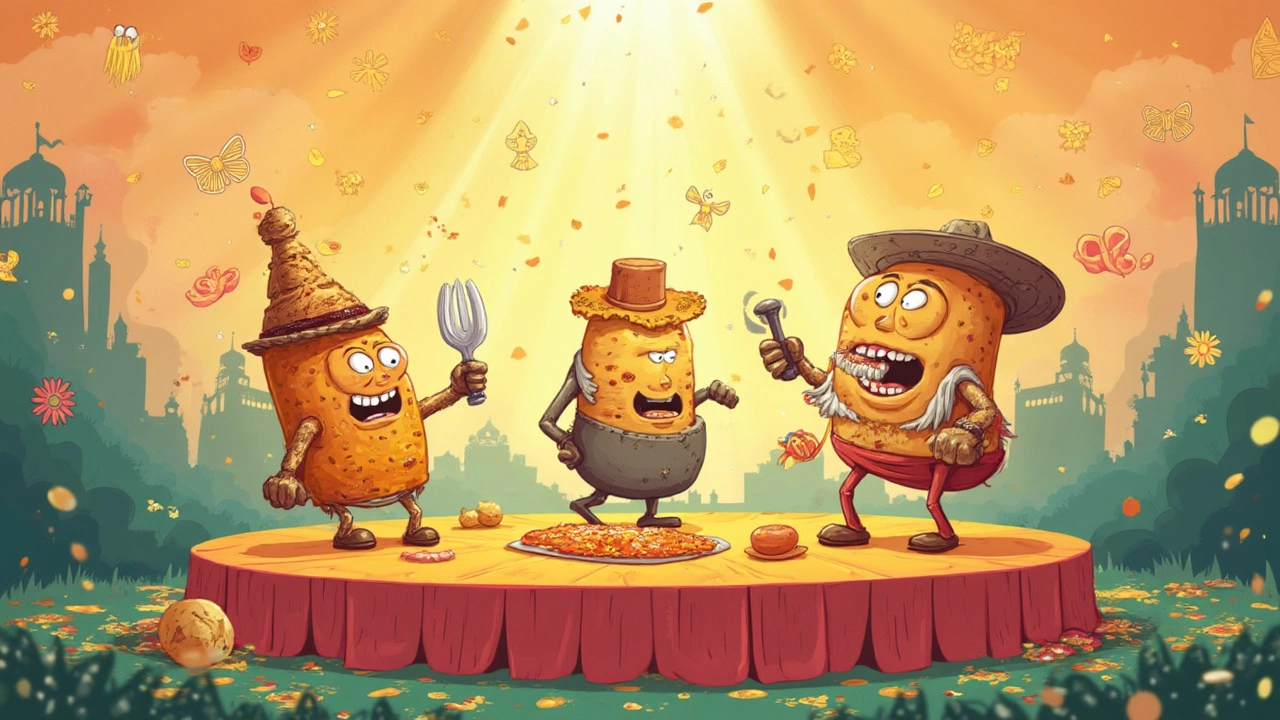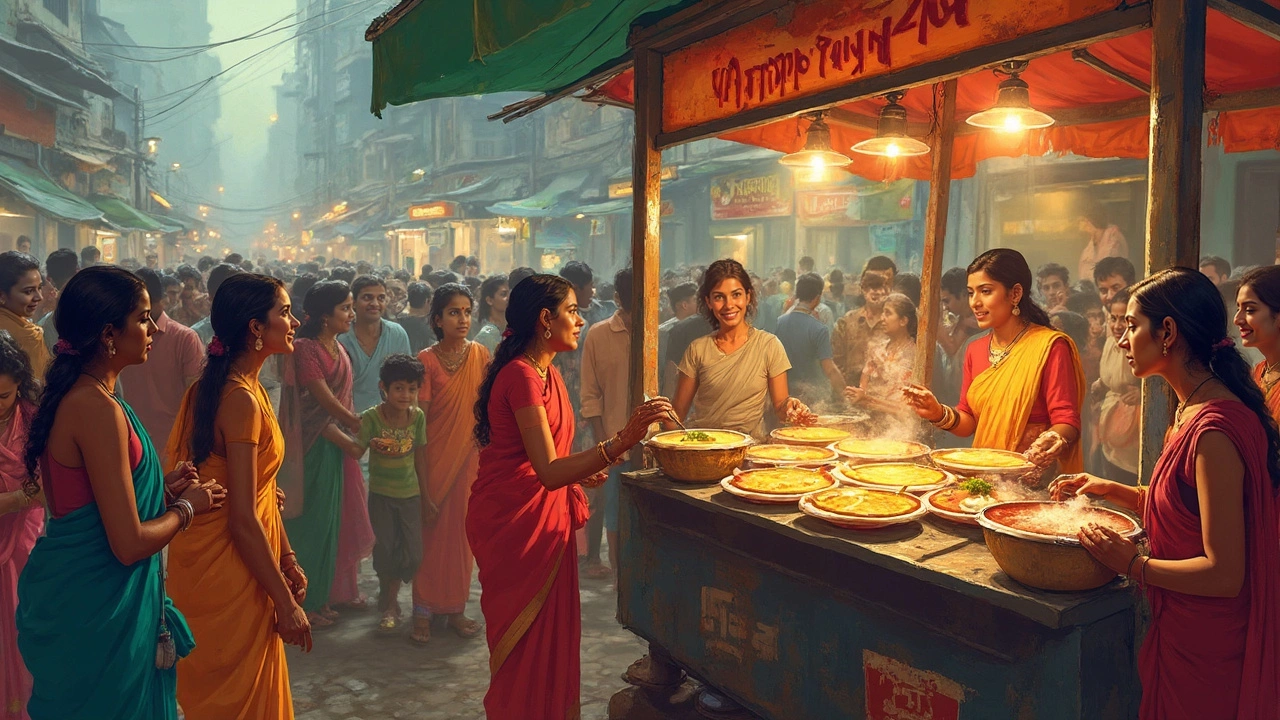India’s vegetarian food is a battleground for favorites. With every region tossing up its own legendary dish, picking one “best” feels almost rebellious. Ever noticed how even hardcore meat lovers in India order a plate of paneer or a sizzling pile of masala dosa without a second thought? That’s Indian vegetarian food for you—bold flavors, tons of options, never boring.
What’s wild is just how normal it is for an entire menu to be vegetarian here. It’s not only about religion or tradition; it’s also about taste. There’s real pride in making a potato curry need no apologies beside a rich lamb biryani. If you’re used to thinking of vegetarian as the boring option, you’ll need to reset your taste buds.
- Why India Has So Many Vegetarian Favorites
- The Frontrunners: Dishes Everyone Talks About
- Regional Rivalries and Secret Local Stars
- Taste Test: How to Choose Your Winner
- Fun Facts and Tips for Trying Indian Vegetarian Food
Why India Has So Many Vegetarian Favorites
If you look at an Indian restaurant menu, you’ll notice that veggie dishes get just as much space as meat ones. It’s not by accident. India has the world’s largest vegetarian population—pretty wild when you think about how deeply food is tied to local life and family.
A lot of this comes down to religion and tradition. Hinduism, Jainism, and Buddhism all shape how and what people eat. Hindus make up most of the country, and many don’t eat beef for religious reasons, while Jains avoid root vegetables and anything that can harm a living being. Meatless cooking became the norm simply because it made daily life way easier for so many families.
But that’s not all. Back in the day, meat could get expensive or was just hard to come by for most people. Farmers and workers needed food that was cheap but filling, so lentils, beans, grains, and veggies became the go-to. Indian cooks learned to crank up the flavor using spices, herbs, and cooking tricks; that’s why even something as simple as dal doesn’t taste boring. Spices do the heavy lifting.
Another fun fact? Indian vegetarian food never feels like it’s “missing” something. It’s got protein from dal (lentils), paneer (cottage cheese), and chickpeas, plus tons of flavor from fresh ginger, garlic, onions, and chilies. These dishes have stood the test of time because people genuinely love eating them, not because they had no other choice.
If you’re new to Indian food, you’ll run into options you may never have heard of in the West. Beyond the vegetarian Indian dishes you might spot in restaurants abroad, there are dozens more local heroes in every state. That variety is why no one ever agrees on the single best veggie dish in India.
The Frontrunners: Dishes Everyone Talks About
When someone asks about the best vegetarian Indian dish, three names always come up first: paneer butter masala, masala dosa, and dal makhani. If you’ve ever been to an Indian wedding or a family celebration, you'll spot at least one of these on the table. They're not just popular in big cities; ask most locals from Delhi to Chennai and you’ll hear the same names dropped everywhere.
Paneer butter masala is a creamy, tomato-based curry with cubes of fresh paneer cheese. It was first made famous by North Indian restaurants and has fans across all ages. The secret? Loads of butter, cream, and bright spices like kasuri methi. If you’re new to Indian food, this dish is a safe bet—it’s not too spicy, it’s super rich, and it pairs perfectly with butter naan.
Then there’s masala dosa. The magic here is in that golden, crispy rice-lentil crepe stuffed with spiced potato. People in Bangalore and Chennai eat it for breakfast, but it’s so filling that it doubles up for lunch or even dinner. You'll find it in every South Indian restaurant worth its salt, served with coconut chutney and sambar.
Don’t forget dal makhani. While it looks simple, it isn’t easy to make right. The black lentils and kidney beans get cooked low and slow with tomatoes, butter, and a swirl of cream. Invented in Delhi’s old-school roadside dhabas, it’s the reason so many people say North Indian food is “comfort food.”
“The soul of Indian cuisine lives in its vegetarian dishes—the variety and depth of flavor are unmatched anywhere in the world.” — Madhur Jaffrey, Indian cookbook author
For some quick comparison, here’s why these three dishes turn up everywhere:
| Dish | Main Ingredients | Origin | When It’s Eaten |
|---|---|---|---|
| Paneer Butter Masala | Paneer, butter, tomato, cream, spices | Punjab/North India | Lunch/Dinner, parties |
| Masala Dosa | Rice, lentils, potato, chutney | Karnataka/South India | Breakfast, any time |
| Dal Makhani | Black lentils, kidney beans, tomato, cream, butter | Delhi/Punjab | Lunch/Dinner |
Most Indian restaurants around the world have these on their menus. If you ask locals why, they’ll tell you it comes down to nostalgia, crowd appeal, and flexibility. These dishes are loved by picky kids and adventurous eaters alike. So if you’re weighing your options, start with one of these and you can’t really go wrong!

Regional Rivalries and Secret Local Stars
When it comes to the best vegetarian dish in India, fierce regional loyalties pop up everywhere. North Indians swear by creamy paneer butter masala and dal makhani paired with soft naan. Down south, you’ll hear passionate debates about masala dosa and sambar, served crisp and piping hot at roadside stalls. Even the west and east of the country have their own claims to fame, making “the best” a hotly contested title.
It isn’t just about which dish tastes better. Indian states have built entire reputations around their local favorites. Take Gujarat, for example. Folks there can’t live without dhokla—a fluffy, steamed savory cake that’s light but seriously addictive. Over in Bengal, shorshe baingan (eggplant in mustard sauce) is all the rage, even though it rarely makes it to mainstream restaurant menus outside the region.
Don’t think for a second that these regional classics are stuck in old traditions. Every corner of India has families putting their own spin on a recipe. Ask a local chef in Lucknow about the city’s vegetarian kebabs—they’ll probably say you haven’t really tried kebabs unless you’ve had theirs, completely meatless but packed with flavor.
"India’s culinary map is like a jigsaw puzzle where every piece tastes different—locals stay loyal to what they grew up eating, and their pride runs deep." — Kunal Kapur, celebrity chef
To show how seriously people take their veggie favorites, check out what’s ordered the most in different regions based on Swiggy’s 2024 food order data:
| Region | Most-Ordered Veg Dish |
|---|---|
| North | Paneer Butter Masala |
| South | Masala Dosa |
| West | Vada Pav |
| East | Chhanar Dalna |
So what’s the tip if you’re traveling? Always ask locals where they eat vegetarian food and don’t just default to the tourist spots. Secret family-run joints and hole-in-the-wall canteens are where you’ll stumble onto flavors you didn’t even know existed. If you’re bored of the popular stuff, try litti chokha in Bihar or patra in Gujarat—unexpected, but unforgettable.
Taste Test: How to Choose Your Winner
So, how do you even start picking the best vegetarian dish in India when there are hundreds to try? There’s no official scorecard, but a few tricks make the decision easier if you’re serious about food or just want to avoid disappointment.
First, think about what you really want from your meal. Do you want something rich and creamy, quick and crispy, or light and healthy? Indian food is all about bold flavors, spices, and textures. Here’s a cheat sheet for picking according to your mood:
- Craving comfort? Dal Makhani, Khichdi, or Rajma-Chawal. These hit all the cozy notes and are found everywhere in North India.
- Love a buttery, luxurious feel? Paneer Butter Masala or Shahi Paneer. The cream and tomato gravy never fails.
- Looking for crispy and light? Masala Dosa or Medu Vada from South India bring crunch and flavor.
- Want something with spice and kick? Chole Bhature or Pav Bhaji. Both pack a punch and are street food legends.
Ask locals or your server what's popular at that place. Many joints have their own twist on classic dishes—like a smoky-tasting dal makhani from Delhi, or extra crunchy dosas in Bangalore. Paying attention to the region often means the dish will taste more "authentic."
If you want the data, check this out:
| Dish | Main Region | How Many Eat It Weekly (Urban %) |
|---|---|---|
| Paneer Butter Masala | North India | 52% |
| Masala Dosa | South India | 46% |
| Dal Makhani | North India | 38% |
| Chole Bhature | Punjabi belt | 35% |
| Pav Bhaji | Western India (Mumbai area) | 29% |
Tip: Don’t judge a dish by its looks. Sometimes the messiest-looking plates are the most satisfying.
Try a small portion, or better yet, go with friends and order different dishes to share. That’s the fastest route to finding your personal winner.

Fun Facts and Tips for Trying Indian Vegetarian Food
Indians have taken vegetarian food to insane levels of variety. Did you know that India has the highest percentage of vegetarians in the world? More than 30% of households skip meat completely, but nobody is missing out. In fact, the first street food stalls in Mumbai used only vegetables—and people still love them.
Here’s something you might not expect: Indian restaurants overseas often mix up paneer and tofu. Real paneer is always made fresh from milk and never tastes rubbery. If you spot a dish like paneer butter masala on the menu, grab it to see what the fuss is about.
- Not all “vegetarian” in India is vegan—most dishes use ghee (clarified butter) or cream, so always ask if you want to keep it plant-based.
- Some regions toss peanuts and coconut into everything (hello, South India). Check ahead if you have allergies.
- Dosa, chaat, and samosas are safe starter choices if you’re nervous about spice.
- Eat with your hands for the real experience—most locals skip the fork when it comes to chapati, naan, or rice.
Ending up with a thali (one huge plate with lots of small dishes) is the fastest way to taste many flavors at once. Most Indian cities offer both casual canteen meals and lavish “pure veg” restaurants, so try both if you can. And if something looks like a dessert but tastes spicy—yup, that’s normal here.
